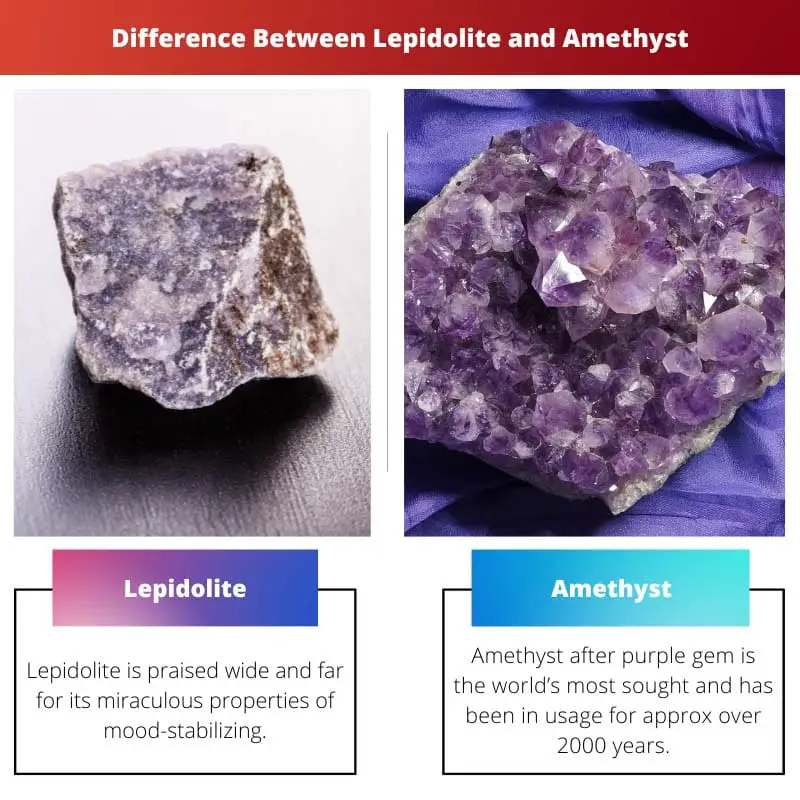When it comes to Crystal healing, it can be described as an alternative medicine practice of pseudo-scientific that uses semi-precious crystals and stones.
The practice’s adherents claim that these have power mainly for healing. Meanwhile, for this claim, there is no such scientific basis.
Crystal healing practitioners believe they can release blocked energy, boost low energy, transform a body’s aura and prevent bad energy.
There are several crystals out on the market, like citrine, garnet, carnelian, hematite, clear quartz, and many more. In this article, the chief aim is to differentiate lepidolite and amethyst.
Key Takeaways
- Lepidolite is a lithium-rich mica mineral known for its lavender to purple hues and flaky, layered structure. At the same time, amethyst is a variety of quartz, characterized by its violet color and found in geodes or as crystals.
- Lepidolite is a source of lithium, used in the production of batteries, ceramics, and glass, while amethyst is primarily used as a gemstone in jewelry and decorative objects.
- Metaphysically, lepidolite promo tes emotional balance and stress relief, whereas amethyst is associated with spiritual growth, protection, and the enhancement of psychic abilities.
Lepidolite vs Amethyst
The difference between lepidolite and amethyst is that breaking harmful psychologic patterns, alleviating depression, releasing stagnant negative energies, and assisting in addiction treatment are some of the benefits of using lepidolite. On the other hand, the benefits of using amethyst are immune system enhancement, hormone regulation, headache reduction, digestive health promotion, and many more.

Lepidolite is praised wide and far for its miraculous properties of mood-stabilizing. This crystal comprises a high lithium percentage, used in anti-anxiety treatments.
This crystal is brittle and soft and can only be shaped and cut inside a larger quartz body.
Amethyst, after purple gem, is the world’s most sought-after and has been in usage for approx over 2000 years. It is a famous gem in the new age due to its affordability, attractive colours, and good durability.
As per astrology, amethyst is an astrological alternative to blue sapphire.
Comparison Table
| Parameters of Comparison | Lepidolite | Amethyst |
|---|---|---|
| Color | Ranges from purple to pink | Ranges from pale lilac to deep reddish-purple |
| Lustre | Pearly to vitreous | Vitreous |
| Crystal system | Monoclinic | Hexagonal |
| Mohs hardness | Rate 2.5 to 3.5 | Rate on 7 |
| Streak | White to colorless | Colorless |
What is Lepidolite?
Lepidolite is a rose or lilac-gray-colored member of the mica’s mineral group. It is the most abundant mineral-bearing lithium and also this metal’s secondary source.
It is a mineral of phyllosilicate and polylithionite trilithionite series member. It is a part of three-part series comprising lepidolite and polylithionite.
All three minerals share similar properties and are caused due to aluminium and lithium’s varying ratios in their chemical formulas.
Lepidolite is found naturally in a range of colors like red, purple, and pink but also grey and colorless and yellow rarely.
Lepidolite is a lithium-bearing mica and that’s why it is wrongly assumed that lithium is what leads to the pink hues that are so mineral’s characteristics.
Instead, it is a trace and manganese amounts that lead to red, purple, and pink colors. It is linked with other minerals bearing, such as spodumene, in pegmatite bodies.
In 1861, Gustav Kirchhoff and Robert Bunsen extracted 150 kg of lepidolite, yielded a rubidium’s few grams of salts for analysis, and discovered the new element rubidium.
It occurs in granite pegmatites, mainly in some granite granites, Greisens, and quartz vein’s high temperatures.

What is Amethyst?
Amethyst is a violet quartz variety. Amethyst was worn by ancient Greeks and carved vessels for drinking from it in the belief to prevent intoxication.
It owes its violet color due to iron’s impurities, irradiation, and other elements’ presence, resulting in substitutions of the complex crystal lattice.
The amethyst’s meaning varies from culture and time to time, which is why amethyst has distinctive meanings in Feng Shui and also focuses on wealth boost.
In ancient China, amethyst is a powerful tool to drive away from daily life’s hazards and negative energies.
Synthetic or simply laboratory-grown amethyst is manufactured by a synthesis method known as hydrothermal growth, and inside a high-pressure autoclave, the crystals grow.
It is made to imitate the amethyst’s best quality. With absolute certainty, it fails to differentiate without advanced gemological testing.
The gem amethyst’s suitable setting is a bezel or prong setting. The method of the channel is used with caution. It has good hardness, and with proper care, handling prevents any stone damage.
Amethyst might change or lose its color with exposure to prolonged light or heat.

Main Differences Between Lepidolite and Amethyst
- When it comes to the formation, the formation of lepidolite occurs mainly in granite pegmatites, in high-temperature granites, Greisens, and quartz veins. In contrast, amethyst forms inside volcanic rocks, and rocks act as vessels that comprise water and minerals over time.
- Lepidolite can be found in many countries like Manitoba, Brazil, Honshu, Madagascar, and many more. On the other hand, Uruguay and Brazil are two countries where notable amethyst occurrences have been found.
- Lepidolite, as a material, can be used to produce many things like tumbled stones, cabochons, ornamental items, and many more. On the flip side, amethyst can be used as faceted stones, beads, ornamental objects, etc.
- In terms of cleavage, it can be described as a molecule’s covalent bond breakage leading to the smaller molecule’s formation. The lepidolite offers perfect cleavage. On the contrary, there is no cleavage in amethyst, and that’s why it breaks along the conchoidal fracture.
- The benefits of using lepidolite are breaking harmful psychologic patterns, releasing stagnant negative energies, assisting in addiction treatment, and many more. Meanwhile, immune system enhancement, headache reduction, and digestive health promotion are some of the benefits of amethyst.

References
- https://www.sciencedirect.com/science/article/pii/S0304386X1200031X
- https://www.sciencedirect.com/science/article/pii/S030645491000304X
